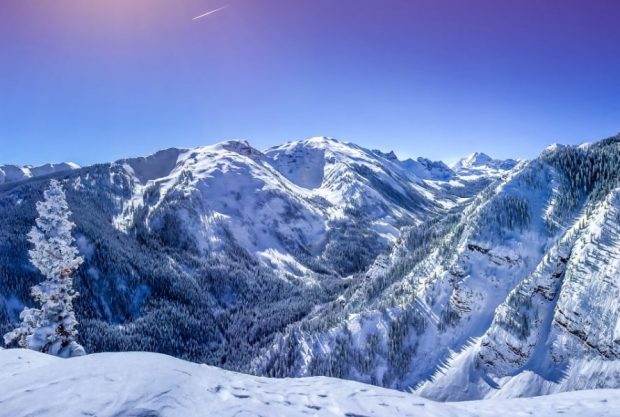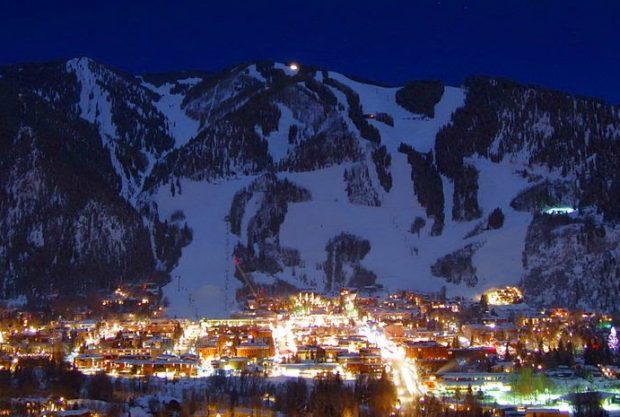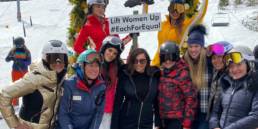Photographs by Daniel Bayer
Aspen Snowmass Skiing Mountains and Money
Aspen Snowmass Skiing Mountains and money in the world’s greatest ski town. It is no big thing to live where you can ski; many people enjoy that luxury. But I am very lucky to be in a place that gives real meaning to the “live” part of that equation. From the top of Aspen Mountain, I can look to the south to see Mount Hayden, big and wild, where the whole improbable dream started. To the west lie Aspen Highlands, Buttermilk, and Snowmass ski areas; anchored by the mountain on which I stand, this is one of the best lineups in the ski world. To the north is my hometown: a tiny, delicate grid spread out at the foot of the mountain. Down there is the world in a diamond-dust snow globe. I could see Buddy Guy tonight at the Belly Up, or I could go check out DJ Dylan. I could take in a lecture by Condoleeza Rice at the Aspen Institute or eat dinner at Cache Cache Bistro across from Kevin Costner. I could party like (and possibly with) a Kennedy at the Caribou Club or have a drink with friends from the ski patrol at the Fraternal Order of Eagles. I could (theoretically) buy a $500,000 watch or a $12 million penthouse, or get the priceless free daily ticket to the Aspen Art Museum to see an exhibition by some of the world’s great artists, many of whom are regular visitors to town. Up on the mountain, I can set my own line or follow in the tracks of local talent like Andy Mill and Anda Smalls, Chris Davenport and Christin Cooper, Gretchen Bleiler and Klaus Obermeyer. I can swallow up 3,000 vertical feet in a few well-placed turns, or carve out a workout on four different 35-degree pitches on one linked run.Y Even the lift rides are an adventure. I ride up with people from all over the world, inevitably including someone who knows someone I know in Austria or Montana or Timbuktu. The skiing world is fairly small and tight, and everyone in it comes through here eventually. Aspen Mountain is the kind of place where, just by showing up, you might witness Donald Trump’s wife and girlfriend stage a catfight for the tabloids. Or you might stumble into a sweet powder day that locals — for the next two decades — will all remember as Big Wednesday. What Aspen ofers is the chance to be a part of something special, unique, and enduring. It has been doing it for more than a hundred years and in a thousand ways. The key is that it’s still bringing the goods. But it hasn’t happened by happy accident. There are always serpents in paradise.

The big silver boom that created Aspen started in 1879. The silver bust was fewer than 15 years later, and it sent the town into a tailspin, albeit one that many still remember fondly as the Quiet Years. The Paepcke family of Chicago rediscovered Aspen in 1939, when Elizabeth “Pussy” Paepcke skied Aspen Mountain after riding up the back side in a mine truck. She was instantly smitten. After World War II, she brought her packaging-mogul husband, Walter, to Aspen, and they poured in money and influence to create the town’s cultural base, laying the groundwork for what eventually became the Aspen Institute and the Aspen Music Festival and School. Pre-WWII attempts to found a ski area on Mount Hayden had faltered, so after the war, efforts focused on the mountain right above town, and the Paepckes helped fund the nascent Aspen Skiing Corporation. Most significantly, many feel, Paepckes created “The Aspen Idea,” a concept of providing a place for the renewal of the mind, body, and spirit. When the early wave of surfers-turned-skiers arrived in Aspen — about the same time as the jazz musicians, literati, and movie stars in the late 1950s—they combined to raise the already active night-life scene to heroic levels. “Back then, every dishwasher had a Ph.D.,” recalls Pulitzer-prize-winning journalist Loren Jenkins, who first came to town in 1955. “I was only 17 and busing tables, and got invited to parties at the Paepckes with all of these important, well known people. It was genuinely classless, and that was special.” Artist Michael Cleverly agrees: “There were no social barriers. The party never ended, and how well you skied was far more important than your net worth.” Today, another Chicago family, the Crowns, owns the Aspen Skiing Company and its four ski areas. Mike Kaplan has been CEO of the ASC for the past six years. “Beyond the physical attributes and sheer beauty, I believe the Aspen Idea is the cornerstone of the community’s long-standing success,” says Kaplan, who lauds people who understand that. “This is a multifaceted place, where people are into many different things. But whatever that pursuit is, people here do it with passion and at the absolute highest level possible.” “The bike riding is obscenely good, the music festival and school is simply No. 1, [and] I won’t even talk about the skiing and riding — you know how I feel about that,” he continues. “The point is, we are a community of fanatics, and what could be more fun than living in a beautiful place, which is great for raising kids, indulging your recreational, intellectual, and aesthetic passions, and hanging out with a bunch of lunatics?” On any given day, you can ride with lunatic ski-film stars, as well as people who rip it just as crazy-big but happen to be waiters or ski tuners or bartenders by night. You can also see A-list celebrities and lots of the zany rich with homes here — Russian oligarchs, members of the Saudi royal family, and at least 50 more of the Forbes 400 wealthiest people. Like everyone else, they came here because it was unique and they wanted to be part of it. And so they bought in. Call it the curse of money: Aspen’s affuenza — an affiction in which the billionaires push out the millionaires — is a lingering, chronic case. You’ll hear a number of residents downgrading the diagnosis to terminal, especially if you are sitting in on a city-council meeting any given Monday. With so much to fight for, those who fight are increasingly vocal about the negative effects of all that cash. “We built a Shangri-La we can’t afford to live in,” says longtime local Georgia Hanson, who is the president/CEO of the Aspen Historical Society. “In an effort to offer seamless world-class amenities to attract more wealth,” she says, “we have created a one-dimensiona town that requires the year-round community to go underground to stay intact.” Certainly, the high cost of living has driven much of the town’s middle class downvalley. “You don’t see [them] now except at work or commuting on the highway,” says Aspen volunteer fire department chief Willard Clapper, who grew up in Aspen. Some locals worry that Aspen is in danger of becoming strictly a town of the served and the servants, and this increasing exclusivity — at restaurants, private clubs, concerts, and parties — limits visitors’ and even residents’ contacts with some of Aspen’s most fascinating people. But people still come and are still wowed; that this is a different, more monied Aspen than the Aspen of 1972 seems, well, immaterial. “Their sense of amazement is based on a totally different view than you or I experienced,” Clapper tells me, “but it is still inspiring to them, and they want to be part of it.” And there are reasons most natives and longtime locals are still here too. “Aspen is pretty much paradise,” says 24-year-old Aspen native and champion freeskier Jacqui Edgerly, who takes full advantage of it. “Everyone is happy to be living it up. Ski every day, party most nights, sleep, and do it all over again. Everything is close, which makes the town ridiculously convenient and efficient. The parties are wild, people are stoked — young and old, rich and broke. It is beautiful and happening, all the time.” From world-class lodging, dining, music, and culture, to the classy and the clueless of the world roaming the streets, Aspen represents. And the spirit of what Aspen has always meant isn’t just confined to that tidy town huddled at the base of Aspen Mountain or the posh addresses. Whether it’s great family hotels and beautiful private homes for rent in Snowmass, flash-mob-style après at Highlands, BIFs at Hunter S. Thompson’s former haunts in Woody Creek, burn-it-down deck bands on Fanny Hill, or all kinds of modern cuisine and old souls in Basalt and Carbondale, the best of Aspen is really spread up and down the Roaring Fork Valley.Y “The natural environment is the key to Aspen’s success,” says accountant and global alpinist Mike Marolt, a fourth generation Aspenite. “Having climbed and skied all over the planet, there ispositively nothing that compares to the natural beauty we have here in the Elk Mountains.” Former ski racer Mark Tache, who grew up in Aspen, agrees. He and his wife, Ketchum-bred racing legend Christin Cooper, are on the move a lot with their business obligations. “Traveling so much has only cemented our love for Aspen Snowmass — the size, the ski traditions, the backcountry access, the high altitude, the old-guard local culture,” says Tache. “The combination is just not easily duplicated anywhere in the world, and we’ve been most everywhere.” As the ante has been upped around the world on powder skiing of the big air, gnarly pitch, cover-shot variety, Aspen and the Roaring Fork Valley have kept pace.Y The mountains provide some of the best skiing in the world, on-piste and of, in terms of pure size, range, and conditions. There is no better family skiing anywhere than the 3,000-plus acres of Snowmass, with the longest vertical in the U.S. at 4,406 feet. Aspen Mountain is one of the biggest and steepest “small” mountains in the country, loaded with flash and glamour. Highlands is the quintessential local’s mountain, and can claim the most extreme inbounds in Colorado. And Buttermilk hosts scores who climb uphill every day for a workout, savvy locals who grab a few powder runs over lunch, and the world that comes to be blown away by the Winter X Games every year. Clearly there’s a lot worth fighting for here, including a real town — with its color, charm, and warmth — as opposed to a purpose built destination. And the sensibility to preserve that town as much as possible — rather than steamrolling it in the name of more leasable space — has been immensely important in Aspen’s development. It was a product of the passion Aspen evokes in people to try to preserve it. And of course, a lot of that passion would be unrequited if i weren’t for an abundance of money here. It contributes substantially to the modern, high-end health-care facilities, hospitals, schools, and libraries valleywide, along with heavily subsidized employee housing and public-transportation programs. Without the wealth, the extensive cultural base that is one of Aspen’s major underpinnings simply wouldn’t exist. Nor would most of the other 500-plus nonprofits that fund everything from computer literacy for the disadvantaged to giving children with cancer the chance to dream. Longtime local benefactor George Stranahan founded the Aspen Center for Physics, the Community School, the Carbondale Community School, and the Compass Foundation for education in the valley, contributing millions locally over his lifetime. “There’s so much money in Aspen — 50-plus billionaires — that there’s no room for anyone to swagger,” he says. When mega-hedge-fund founder John Paulson recently purchased former Saudi ambassador to America Prince Bandar bin Sultan’s local estate for $49 million, he released a statement that read, “Initially offered for sale for $135 million, the purchase price represents a substantial discount to the asking price.” That could perhaps be taken for swagger. But Paulson has been visiting Aspen for 25 years, since well before he became a billionaire and the town became full of them. So he obviously has liked it, and still does, for some of the same reasons everyone else does, stating that he and his family “intend to stay in Aspen for many years to come.”Big money has also helped sustain the local economy and jobs. While other major ski resorts have seen recent real estate slumps that equated to virtually no sales for several years, Aspen’s countywide annual sales “dipped” to a billion dollars. True, it was down from $2.5 billion, and some realtors lost their jobs, but still. And so some wonder if it’s really possible to have too much money, or if this hand-wringing is just another manifestation of Aspen’s famous self-absorption, constantly worrying that it has become too famous — as in, too thin or too rich. No one believes you can preserve anything forever, let alone such highly sought ephemerals as paradise and innocence.

The big question for Aspen has been how to change without losing what the community values most. “[We must] honor our surroundings and their lure for people from all over the world,” says attorney Jamie Knowlton, the son of one of Aspen’s best-known skiing pioneers, Steve Knowlton. “The valley has changed people more than people have changed the valley,” he notes. Knowlton believes that the biggest challenge is “handling the changes with equanimity and perspective.” “I didn’t say it would be easy,” he adds with a knowing smile. And it never has been. CEO Kaplan is one of those who asks: “Too much money, that’s a big problem? As a community, we should be lattered and appreciative that capital is attracted to our valley. We should be welcoming but thoughtful about how to put that capital to work. “We need to embrace these potential investors, engage them in a conversation about community goals and objectives,” he continues, “and work with them to create a project or development that meets both the investors’ criteria and our goals as a community.” Though excessive or inappropriate development has been an issue in Aspen and many resorts for years, local governments have developed stringent regulations to inhibit abusive land use. What is less governable is attitude. It’s more than “making dif cult zoning and rules,” which Marolt notes is key to the process. “But it’s also about making sure people are aware of the core issue: what we are and why we are,” and getting them to buy into that as well. In the end, you can’t buy a better view from the mountains, especially the ones you have to climb on your own. You can’t buy cleaner air or more stars in the night sky. There isn’t a price yet on getting to know remarkable people from all walks of life, the sweetest line down the Mine Dumps, or which bartender makes the best margarita in town. Knowing how to ski the local terrain like it’s in your DNA, knowing half of the oldtimers in the valley, knowing who needs help and how to give it — none of that can be bought. Not with any coin of this realm other than passion and commitment. And that, not money, is the heart of the real Aspen Snowmass skiing, and the reason it’s the greatest ski town in the world.




